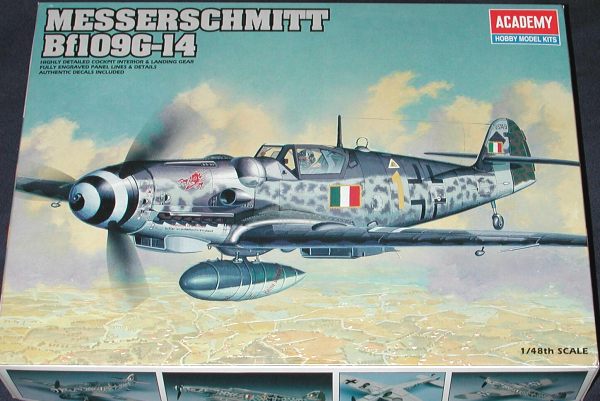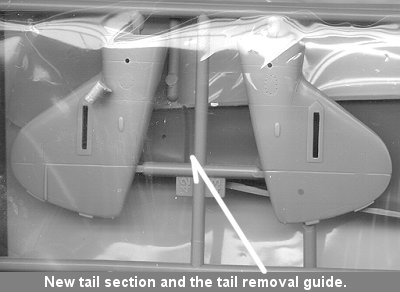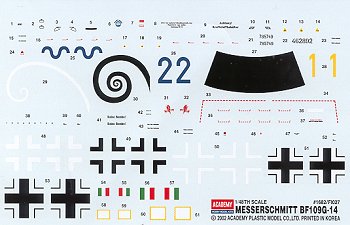
|
KIT: |
Academy 1/48 Bf-109G-14 |
|
KIT # |
1682 |
|
PRICE: |
$22.00 |
|
DECALS: |
Two aircraft |
|
REVIEWER: |
|
|
NOTES: |
Ex-Hobbycraft mold |

|
HISTORY |
The last of the true G series Bf-109s was the Bf-109G-14. This was basically an upgrade of the G-6 aircraft with most G-14s having the taller wooden tail. Two major variants of the G-14 were produced. One was the standard G-14. This aircraft was visually identical to many late-production G-6s. The other was the G-14/AS. This was a high altitude version and could be distinguished from the 'standard' aircraft by the smoother engine cowling that eliminated the 'bumps' on the cowling over the machine gun feeds. However, it is not a definite indication of sub-type as again, some 109G-6/AS machines were similar. Generally, the G-6/AS had the shorter tail. Both the G-6 and G-14 had the small upper wing wheel 'bumps', though to be pedantic about any 109 subtype when it came to the last two years of the war is just asking for trouble! As with many later 109s, some G-14s were converted from G-6 airframes undergoing repair, however the vast majority were new builds.
|
THE KIT |
 In terms of the kit itself,
there are no real differences between this on and the
Bf-109G-6 that Academy produces. There are
only a few differences in this kit; one is that this kit includes the taller
wooden tail unit that is typical of the G-14. To do this, Academy has scribed an
area on the rear fuselage for you to cut in order to put in place the new tail
unit. While not my favorite way of doing things, it does work. Another is that
it includes the Erla Haube or 'Galland' hood. Not all G-14s had this option, but
it was a common enough option. This hood became available around mid-1943 and
was often retrofitted to the G-6. Later G-6s had this as a standard feature.
In addition, there is a second drop tank version. Missing from this kit are the
under wing cannon.
In terms of the kit itself,
there are no real differences between this on and the
Bf-109G-6 that Academy produces. There are
only a few differences in this kit; one is that this kit includes the taller
wooden tail unit that is typical of the G-14. To do this, Academy has scribed an
area on the rear fuselage for you to cut in order to put in place the new tail
unit. While not my favorite way of doing things, it does work. Another is that
it includes the Erla Haube or 'Galland' hood. Not all G-14s had this option, but
it was a common enough option. This hood became available around mid-1943 and
was often retrofitted to the G-6. Later G-6s had this as a standard feature.
In addition, there is a second drop tank version. Missing from this kit are the
under wing cannon.
Now having said all of that, you can build a late G-6 with this kit; either by using both the tall tail and canopy or by just using one or the other. The key, of course, is to have some sort of reference photo. A couple of things that are a bit odd concerning the instructions. One is that it offers the umbrella. These were generally only used by the /trop variants. These will have small fairings on the fuselage in which to attach this umbrella. Check your references. The other is that the gear doors are shown as optional on the Italian version. Again, check references. It is true that the gear doors were sometimes left off, but this was usually in areas of heavy snow or mud.
 The decal sheet is for two
aircraft. One is the box art airplane from 5 Squadriglia, 2 Gruppo of the ANR in
March 1945. This one is shown in RLM 74/75/76 with the rudder in RLM 81/82.
Pretty much the standard scheme of the time as these planes were delivered
either straight from the factory or from Luftwaffe units. The other is for Blue
2 from 16./JG 43 in January 1945. This one is in the late war colors of RLM
81/82/83 over RLM 76 with a black RVD band. I'd recommend painting this on as I
don't trust many of these kinds of decals. The decals themselves are well
printed and glossy. No swastika is provided. Academy decals usually work quite
well, though there are lots of aftermarket ones around if you so desire. BTW, on
the box art, it looks as if the drop tank is painted grey on the upper side. It
isn't, so don't be fooled.
The decal sheet is for two
aircraft. One is the box art airplane from 5 Squadriglia, 2 Gruppo of the ANR in
March 1945. This one is shown in RLM 74/75/76 with the rudder in RLM 81/82.
Pretty much the standard scheme of the time as these planes were delivered
either straight from the factory or from Luftwaffe units. The other is for Blue
2 from 16./JG 43 in January 1945. This one is in the late war colors of RLM
81/82/83 over RLM 76 with a black RVD band. I'd recommend painting this on as I
don't trust many of these kinds of decals. The decals themselves are well
printed and glossy. No swastika is provided. Academy decals usually work quite
well, though there are lots of aftermarket ones around if you so desire. BTW, on
the box art, it looks as if the drop tank is painted grey on the upper side. It
isn't, so don't be fooled.
|
CONCLUSIONS |
As with the Hobbycraft kits, this will make a very nice Bf-109 model. The detailing is very good, though not as crisp as what is with the Hasegawa kit. I have seen these made into winners at contests, so it really isn't all that bad. It is also simple enough to be attractive to those who don't want to mess with all the fiddly stuff that are normal on Hasegawa kits. It also has the benefit of being a lot less expensive in several parts of the world than the Hase kit.
If you would like your product reviewed fairly and quickly where it will be seen by well over 150,000 visitors a month, please contact me or see other details in the Note to Contributors.